Alexei Baevski
Jack
The Llama 3 Herd of Models
Jul 31, 2024Abstract:Modern artificial intelligence (AI) systems are powered by foundation models. This paper presents a new set of foundation models, called Llama 3. It is a herd of language models that natively support multilinguality, coding, reasoning, and tool usage. Our largest model is a dense Transformer with 405B parameters and a context window of up to 128K tokens. This paper presents an extensive empirical evaluation of Llama 3. We find that Llama 3 delivers comparable quality to leading language models such as GPT-4 on a plethora of tasks. We publicly release Llama 3, including pre-trained and post-trained versions of the 405B parameter language model and our Llama Guard 3 model for input and output safety. The paper also presents the results of experiments in which we integrate image, video, and speech capabilities into Llama 3 via a compositional approach. We observe this approach performs competitively with the state-of-the-art on image, video, and speech recognition tasks. The resulting models are not yet being broadly released as they are still under development.
Toward Joint Language Modeling for Speech Units and Text
Oct 12, 2023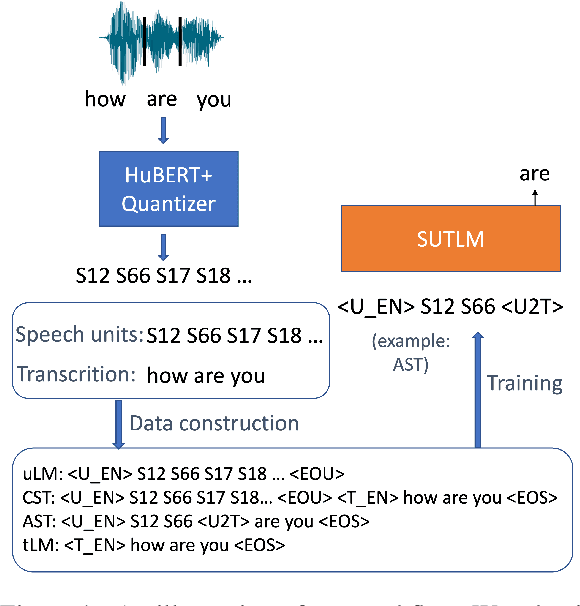

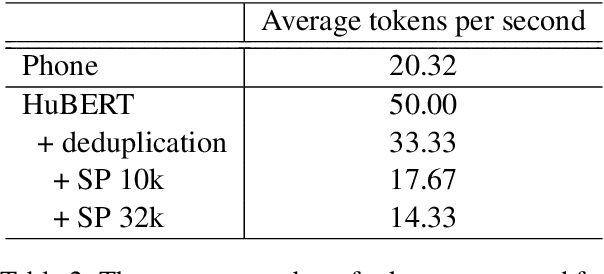

Abstract:Speech and text are two major forms of human language. The research community has been focusing on mapping speech to text or vice versa for many years. However, in the field of language modeling, very little effort has been made to model them jointly. In light of this, we explore joint language modeling for speech units and text. Specifically, we compare different speech tokenizers to transform continuous speech signals into discrete units and use different methods to construct mixed speech-text data. We introduce automatic metrics to evaluate how well the joint LM mixes speech and text. We also fine-tune the LM on downstream spoken language understanding (SLU) tasks with different modalities (speech or text) and test its performance to assess the model's learning of shared representations. Our results show that by mixing speech units and text with our proposed mixing techniques, the joint LM improves over a speech-only baseline on SLU tasks and shows zero-shot cross-modal transferability.
Scaling Speech Technology to 1,000+ Languages
May 22, 2023Abstract:Expanding the language coverage of speech technology has the potential to improve access to information for many more people. However, current speech technology is restricted to about one hundred languages which is a small fraction of the over 7,000 languages spoken around the world. The Massively Multilingual Speech (MMS) project increases the number of supported languages by 10-40x, depending on the task. The main ingredients are a new dataset based on readings of publicly available religious texts and effectively leveraging self-supervised learning. We built pre-trained wav2vec 2.0 models covering 1,406 languages, a single multilingual automatic speech recognition model for 1,107 languages, speech synthesis models for the same number of languages, as well as a language identification model for 4,017 languages. Experiments show that our multilingual speech recognition model more than halves the word error rate of Whisper on 54 languages of the FLEURS benchmark while being trained on a small fraction of the labeled data.
OVRL-V2: A simple state-of-art baseline for ImageNav and ObjectNav
Mar 14, 2023Abstract:We present a single neural network architecture composed of task-agnostic components (ViTs, convolutions, and LSTMs) that achieves state-of-art results on both the ImageNav ("go to location in <this picture>") and ObjectNav ("find a chair") tasks without any task-specific modules like object detection, segmentation, mapping, or planning modules. Such general-purpose methods offer advantages of simplicity in design, positive scaling with available compute, and versatile applicability to multiple tasks. Our work builds upon the recent success of self-supervised learning (SSL) for pre-training vision transformers (ViT). However, while the training recipes for convolutional networks are mature and robust, the recipes for ViTs are contingent and brittle, and in the case of ViTs for visual navigation, yet to be fully discovered. Specifically, we find that vanilla ViTs do not outperform ResNets on visual navigation. We propose the use of a compression layer operating over ViT patch representations to preserve spatial information along with policy training improvements. These improvements allow us to demonstrate positive scaling laws for the first time in visual navigation tasks. Consequently, our model advances state-of-the-art performance on ImageNav from 54.2% to 82.0% success and performs competitively against concurrent state-of-art on ObjectNav with success rate of 64.0% vs. 65.0%. Overall, this work does not present a fundamentally new approach, but rather recommendations for training a general-purpose architecture that achieves state-of-art performance today and could serve as a strong baseline for future methods.
AV-data2vec: Self-supervised Learning of Audio-Visual Speech Representations with Contextualized Target Representations
Feb 10, 2023Abstract:Self-supervision has shown great potential for audio-visual speech recognition by vastly reducing the amount of labeled data required to build good systems. However, existing methods are either not entirely end-to-end or do not train joint representations of both modalities. In this paper, we introduce AV-data2vec which addresses these challenges and builds audio-visual representations based on predicting contextualized representations which has been successful in the uni-modal case. The model uses a shared transformer encoder for both audio and video and can combine both modalities to improve speech recognition. Results on LRS3 show that AV-data2vec consistently outperforms existing methods under most settings.
Efficient Self-supervised Learning with Contextualized Target Representations for Vision, Speech and Language
Dec 14, 2022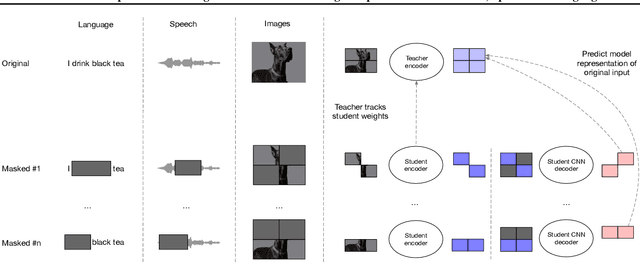
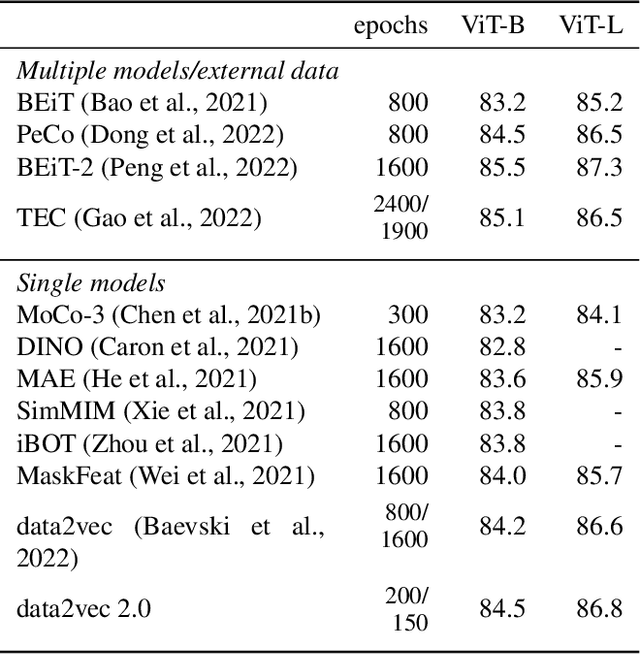


Abstract:Current self-supervised learning algorithms are often modality-specific and require large amounts of computational resources. To address these issues, we increase the training efficiency of data2vec, a learning objective that generalizes across several modalities. We do not encode masked tokens, use a fast convolutional decoder and amortize the effort to build teacher representations. data2vec 2.0 benefits from the rich contextualized target representations introduced in data2vec which enable a fast self-supervised learner. Experiments on ImageNet-1K image classification show that data2vec 2.0 matches the accuracy of Masked Autoencoders in 16.4x lower pre-training time, on Librispeech speech recognition it performs as well as wav2vec 2.0 in 10.6x less time, and on GLUE natural language understanding it matches a retrained RoBERTa model in half the time. Trading some speed for accuracy results in ImageNet-1K top-1 accuracy of 86.8\% with a ViT-L model trained for 150 epochs.
Introducing Semantics into Speech Encoders
Nov 15, 2022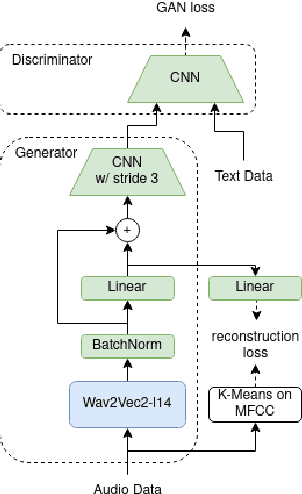
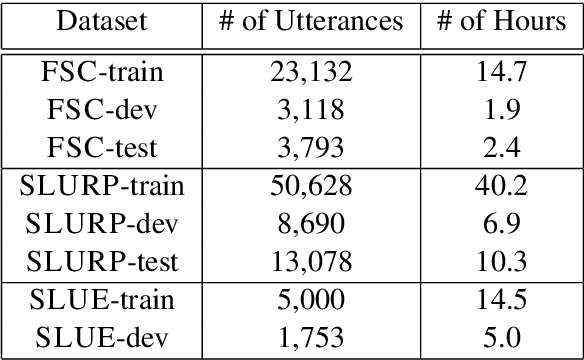
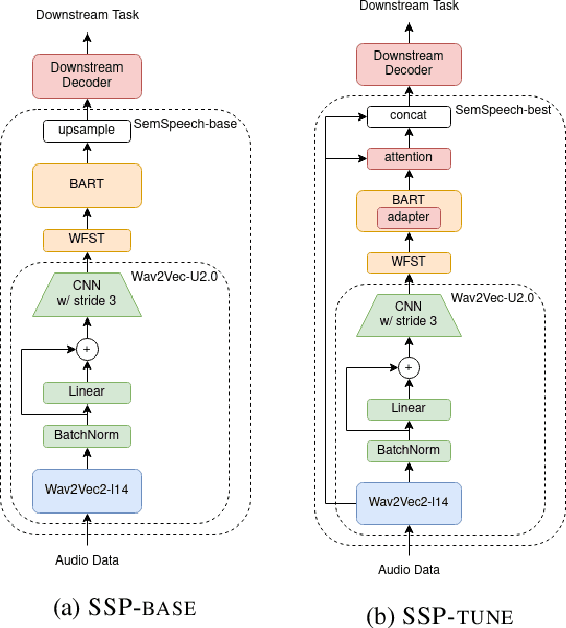

Abstract:Recent studies find existing self-supervised speech encoders contain primarily acoustic rather than semantic information. As a result, pipelined supervised automatic speech recognition (ASR) to large language model (LLM) systems achieve state-of-the-art results on semantic spoken language tasks by utilizing rich semantic representations from the LLM. These systems come at the cost of labeled audio transcriptions, which is expensive and time-consuming to obtain. We propose a task-agnostic unsupervised way of incorporating semantic information from LLMs into self-supervised speech encoders without labeled audio transcriptions. By introducing semantics, we improve existing speech encoder spoken language understanding performance by over 10\% on intent classification, with modest gains in named entity resolution and slot filling, and spoken question answering FF1 score by over 2\%. Our unsupervised approach achieves similar performance as supervised methods trained on over 100 hours of labeled audio transcripts, demonstrating the feasibility of unsupervised semantic augmentations to existing speech encoders.
Masked Autoencoders that Listen
Jul 13, 2022
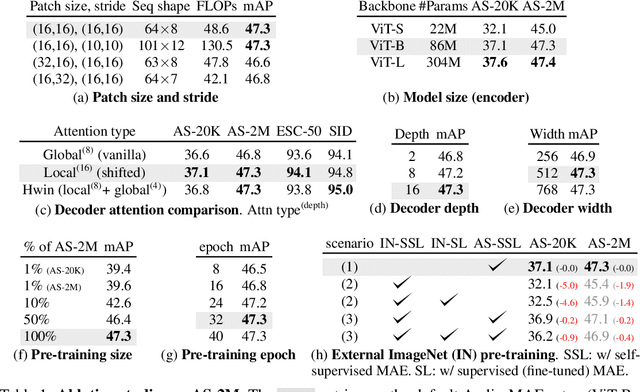

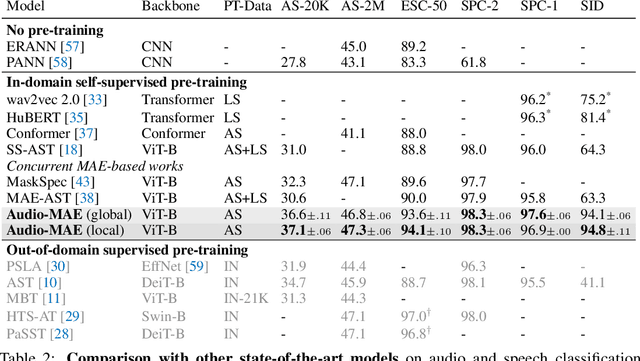
Abstract:This paper studies a simple extension of image-based Masked Autoencoders (MAE) to self-supervised representation learning from audio spectrograms. Following the Transformer encoder-decoder design in MAE, our Audio-MAE first encodes audio spectrogram patches with a high masking ratio, feeding only the non-masked tokens through encoder layers. The decoder then re-orders and decodes the encoded context padded with mask tokens, in order to reconstruct the input spectrogram. We find it beneficial to incorporate local window attention in the decoder, as audio spectrograms are highly correlated in local time and frequency bands. We then fine-tune the encoder with a lower masking ratio on target datasets. Empirically, Audio-MAE sets new state-of-the-art performance on six audio and speech classification tasks, outperforming other recent models that use external supervised pre-training. The code and models will be at https://github.com/facebookresearch/AudioMAE.
Wav2Vec-Aug: Improved self-supervised training with limited data
Jun 27, 2022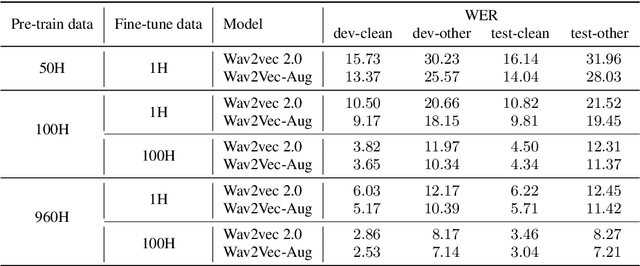
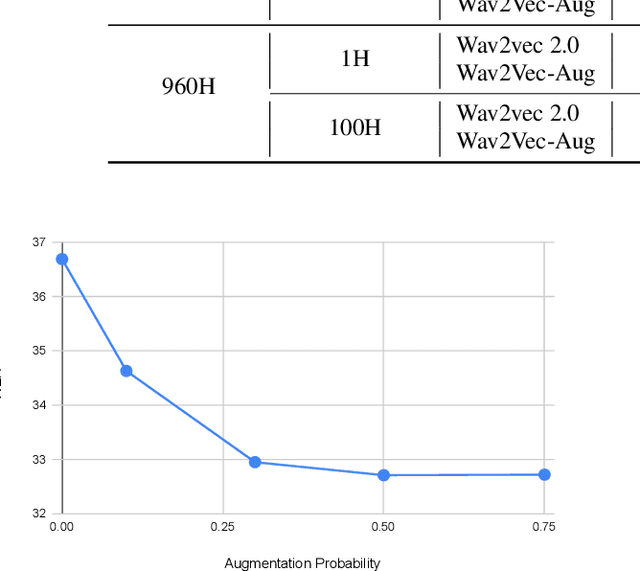
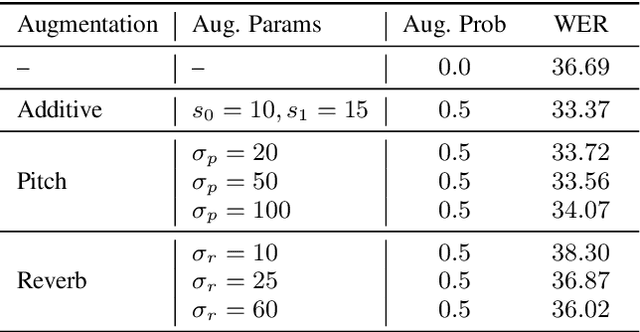
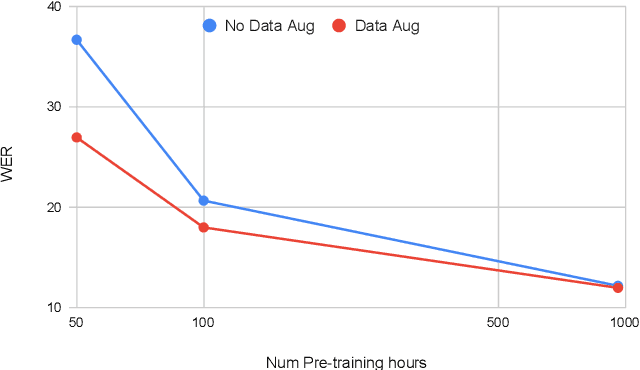
Abstract:Self-supervised learning (SSL) of speech representations has received much attention over the last few years but most work has focused on languages and domains with an abundance of unlabeled data. However, for many languages there is a shortage even in the unlabeled data which limits the effectiveness of SSL. In this work, we focus on the problem of applying SSL to domains with limited available data by leveraging data augmentation for Wav2Vec 2.0 pretraining. Further, we propose improvements to each component of the model which result in a combined relative word error rate (WER) improvement of up to 13% compared to Wav2Vec 2.0 on Librispeech test-clean / other.
Offline Visual Representation Learning for Embodied Navigation
Apr 27, 2022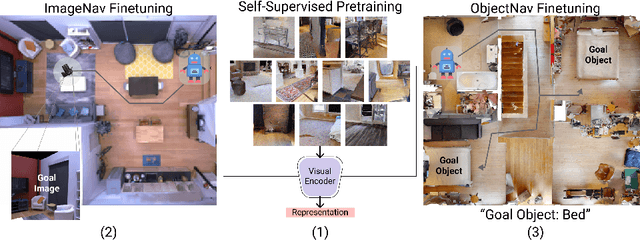
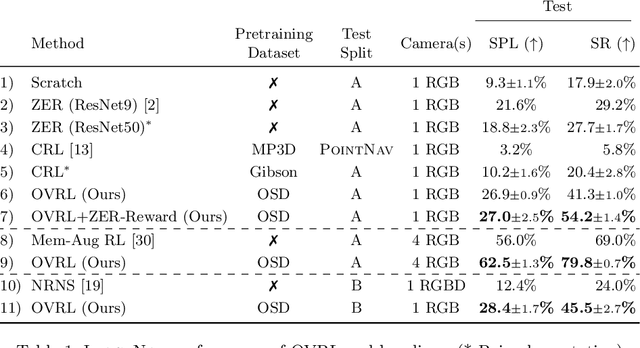

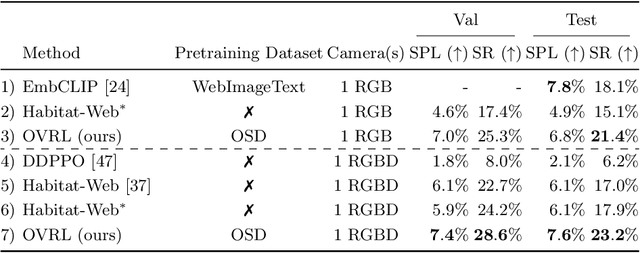
Abstract:How should we learn visual representations for embodied agents that must see and move? The status quo is tabula rasa in vivo, i.e. learning visual representations from scratch while also learning to move, potentially augmented with auxiliary tasks (e.g. predicting the action taken between two successive observations). In this paper, we show that an alternative 2-stage strategy is far more effective: (1) offline pretraining of visual representations with self-supervised learning (SSL) using large-scale pre-rendered images of indoor environments (Omnidata), and (2) online finetuning of visuomotor representations on specific tasks with image augmentations under long learning schedules. We call this method Offline Visual Representation Learning (OVRL). We conduct large-scale experiments - on 3 different 3D datasets (Gibson, HM3D, MP3D), 2 tasks (ImageNav, ObjectNav), and 2 policy learning algorithms (RL, IL) - and find that the OVRL representations lead to significant across-the-board improvements in state of art, on ImageNav from 29.2% to 54.2% (+25% absolute, 86% relative) and on ObjectNav from 18.1% to 23.2% (+5.1% absolute, 28% relative). Importantly, both results were achieved by the same visual encoder generalizing to datasets that were not seen during pretraining. While the benefits of pretraining sometimes diminish (or entirely disappear) with long finetuning schedules, we find that OVRL's performance gains continue to increase (not decrease) as the agent is trained for 2 billion frames of experience.
 Add to Chrome
Add to Chrome Add to Firefox
Add to Firefox Add to Edge
Add to Edge